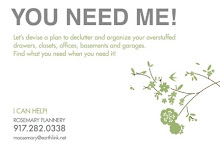Thursday, November 25, 2010
Think Before You Shop
Happy Thanksgiving!
Monday, November 15, 2010
From Clutter2Clarity: Packing Up for a Remodel
Sunday, November 7, 2010
From Clutter2Clarity: Finishing up the creation a...
Finishing up the creation a...: "Finishing up the creation and organization of Every Day With Rachel Ray's in-house library. Here's a sneak peek:"
Monday, November 1, 2010
From Clutter2Clarity: Kids Are Never Too Young To Pitch In
Kids Are Never Too Young To Pitch In
Clients often complain that their homes are in disarray due to their kids' toys and other belongings cluttering up the house. Recently on the blog, Unclutterer, I read about some tips to rectify the problem, so I am passing them onto my followers. Some of these practices can also be applied to your spouse or roommate. Good luck!
Encouraging young children to clean up their toys
A common topic of discussion among the parents in my son’s playgroup is:
How do we teach our children to put away their toys?
Our children are only one year old, which means we don’t yet have much of a problem, but we’re eager to ensure we don’t have problems later. We want our children to develop life-long skills that help them to be organized and respectful of their things in the future. We might fail miserably — kids have amazing will-power — but here is what we’re trying:
- Model the behavior. It’s tempting, especially with small children around, to wait until after the kids go to bed to pick up the house. However, children should watch and “help” you clean up so they can start to mimic your actions. Otherwise, they’re under the impression that a magical fairy appears and cleans up the toys, coloring books, and wooden spoons.
- Explain the process. As you put away toys and project materials, talk through what you’re doing. “I’m putting the lids on these markers so they won’t dry out and you can use them next time you want to color.” “I’m putting these books on the bookshelf because it’s where they belong when you’re not reading them. The bookshelf protects the books from being damaged so you’ll have them the next time you want to read them.” I should admit that this narration is extremely tedious, but I’ve noticed my son incorporating words into his vocabulary like shelf and cap, so I at least know he’s listening.
- Be positive. Look for ways to make the clean up process as interesting as the play. Put on fun, fast-paced music your child enjoys every time you pick up toys and dance while you work. Make up a cleaning song to sing or play a counting game. Voices shouldn’t be raised and threats shouldn’t be wagered.
- Give your child time. Clean up for young children shouldn’t be rushed. If the child has an hour to play, budget the last 10 minutes of that playtime to picking up the toys. Let your child know that playing with toys involves taking the time to put them away. This is similar to dinner not being finished until the dishes are cleaned, the table is wiped off, and all of the ingredients returned to the pantry or refrigerator. Playtime includes putting away the toys.
- Be consistent. This is the hardest part of the teaching process for me — making sure I always leave time for picking up toys. If we’re in a rush to get out the door to run an errand, it’s difficult to pause and make sure the toy is returned to it’s storage place before we leave the house. The consistency and repetitive action, however, are what instill the positive behavior. If a child doesn’t know there is the option to leave his toys strewn about the room, he won’t make that decision. (Well, at least in theory.)
Versions of this can be used with older children. When I was teaching high school, I’d let the students know when they had three minutes left in the period so they could gather up their materials and be ready to leave when the bell sounded. When the students were working in groups, I’d have them race to see which group could clean up their workstation the quickest. I’d award imaginary points to students when they found something of mine left in the classroom: “5,000 points to Gryffindor!” But, I never gave real rewards (no points, no gold stars, no treats), since I believe that cleaning up is a sign of respecting materials the school provided and an expected behavior of all the students.
What techniques have you used with your children or students to encourage them to pick up their toys? Share your tips in the comments.
Posted by Erin on Oct 25, 2010 | Comments

